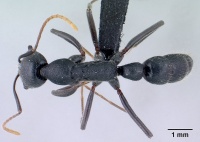Leptogenys lavavava
| Leptogenys lavavava | |
|---|---|

| |
| Scientific classification | |
| Kingdom: | Animalia |
| Phylum: | Arthropoda |
| Class: | Insecta |
| Order: | Hymenoptera |
| Family: | Formicidae |
| Subfamily: | Ponerinae |
| Tribe: | Ponerini |
| Genus: | Leptogenys |
| Species group: | incisa |
| Species complex: | imerinensis |
| Species: | L. lavavava |
| Binomial name | |
| Leptogenys lavavava Rakotonirina & Fisher, 2014 | |
This species forages most frequently on the forest floor and rarely on lower vegetation. Colony nests were found only in rotten logs.
Identification
A member of the imerinensis complex of the incisa species group. Rakotonirina and Fisher (2014) - Worker. Median portion of clypeus abruptly projecting anteriorly into a toothlike spine; a pair of peg-like setae projecting anteriorly from the side, near the apex of the spine; basal portion of mandible distinctly, broadly curved, extending laterally beyond the widest level of the sides of head; antennal scape relatively short; in full-face view, eye breaking lateral cephalic margin; erect hairs of antennal scape longer than maximum width of scape; posterior face of petiolar node without impression or groove near its posteroventral portion.
This species is easily recognized by the spiniform shape of the anteromedian lobe of clypeus, the broad convexity of the base of mandible extending laterally beyond the level of the lateral cephalic margin, and the elongate antennal scape. The other similar species such as Leptogenys chrislaini and Leptogenys barimaso have shorter anteromedial clypeal lobe and the base of the mandible does not project beyond the lateral cephalic margin in full face view.
Keys including this Species
Distribution
The distribution of this species is confined to two localities in the central-east of Madagascar, the RNI Betampona and the RS Ambatovaky, between 390 m and 520 m.
Latitudinal Distribution Pattern
Latitudinal Range: -17.8867° to -17.8867°.
| North Temperate |
North Subtropical |
Tropical | South Subtropical |
South Temperate |
- Source: AntMaps
Distribution based on Regional Taxon Lists
Malagasy Region: Madagascar (type locality).
Distribution based on AntMaps
Distribution based on AntWeb specimens
Check data from AntWeb
Countries Occupied
| Number of countries occupied by this species based on AntWiki Regional Taxon Lists. In general, fewer countries occupied indicates a narrower range, while more countries indicates a more widespread species. |

|
Estimated Abundance
| Relative abundance based on number of AntMaps records per species (this species within the purple bar). Fewer records (to the left) indicates a less abundant/encountered species while more records (to the right) indicates more abundant/encountered species. |

|
Biology
|
Castes
Male
Images from AntWeb
    
| |
| Male (alate). Specimen code casent0135859. Photographer Dimby Raharinjanahary, uploaded by California Academy of Sciences. | Owned by CAS, San Francisco, CA, USA. |
Nomenclature
The following information is derived from Barry Bolton's Online Catalogue of the Ants of the World.
- lavavava. Leptogenys lavavava Rakotonirina & Fisher, 2014: 88, figs. 58A, 102, 118 (w.) MADAGASCAR.
Unless otherwise noted the text for the remainder of this section is reported from the publication that includes the original description.
Description
Worker
(7 specimens). HW: 1.60–1.73, HL: 2.06–2.18, CI: 77–81, SL: 1.88–2.06, SI: 117–123, PW: 1.12–1.18, WL: 3.04–3.28, PNH: 0.80–0.87, PNL: 0.89–0.97, PNW: 0.77–0.85, DNI: 85–91, LNI: 86–93.
In full-face view, head widest in front of eye; lateral margin somewhat convex but width increasing anteriorly toward the base of mandible. Eye medium, maximum diameter larger than greatest width of scape. Scape relatively long, less than one third of the length reaching posterior margin of head. Anteromedian margin of clypeus abruptly projecting into sharp, toothlike spine; pair of peg-like setae present near its apex. Mandible long and narrow, outer margin strongly convex near base, extending laterally beyond the outline of side of head and becoming relatively straight toward the apices, terminating into slightly curved, sharp apical tooth; large gap present between clypeus and blades when latter at rest; preapical tooth completely absent, or present on one or both blades near apical tooth; basal groove visible. In full-face view, hypostomal teeth not visible. With mesosoma in side view, propodeum fairly long and low; posterolateral margin without lobe. In dorsal view, metanotal groove distinct, with transverse rugulae; small transverse sclerite present between groove and propodeum. Node of petiole longer than broad in dorsal view, width reduced toward the anterior margin. With petiole in profile, node longer than high; the shorter anterior margin forming a convex outline with the dorsal margin, which meets the slightly anteriorly inclined posterior margin at distinct angle; posterior margin of node without constriction at posteroventral angle. Abdominal segments III and IV with visible constriction. Sculpture of mandibular blades finely striate and interspersed with small piligerous pits. Dorsum of head, mesosoma and petiolar node densely and finely reticulate-rugose; coarse rugae present on propodeal dorsum. Third abdominal tergite reticulate-punctulate to densely punctulate. Slender, yellowish, erect hairs present; pubescence quite abundant. Body color black, appendages dark brown, with lighter apices; apical portion of antennal segments brown but becoming yellow toward the apex.
Type Material
Holotype worker: Madagascar, Toamasina, RNI Betampona, Camp Vohitsivalana, 37.1 km 338° Toamasina, -17.8867, 49.2025, 520 m, rainforest, ex rotten log, 3 Dec 2005 (B.L. Fisher et al.), collection code: BLF13354, specimen code: CASENT0067405 (California Academy of Sciences). Paratypes: 5 workers with same data as holotype but with the following specimen codes: CASENT0247261, CASENT0247260, CASENT0247259, CASENT0247258, CASENT0247257 (CASC, The Natural History Museum, Musee d'Histoire Naturelle Genève, Parc Botanique et Zoologique de Tsimbazaza).
References
- Rakotonirina, J.C. & Fisher, B.L. 2014. Revision of the Malagasy ponerine ants of the genus Leptogenys Roger (Hymenoptera: Formicidae). Zootaxa 3836, 1-163.
References based on Global Ant Biodiversity Informatics
- Rakotonirina J. C., and B. L. Fisher. 2014. Revision of the Malagasy ponerine ants of the genus Leptogenys Roger (Hymenoptera: Formicidae). Zootaxa 3836 (1): 001163.


